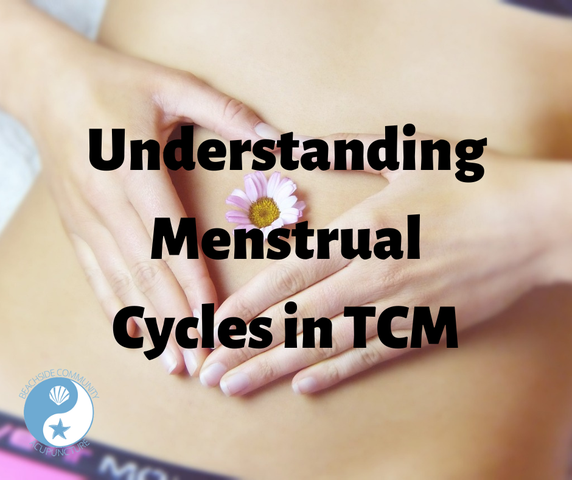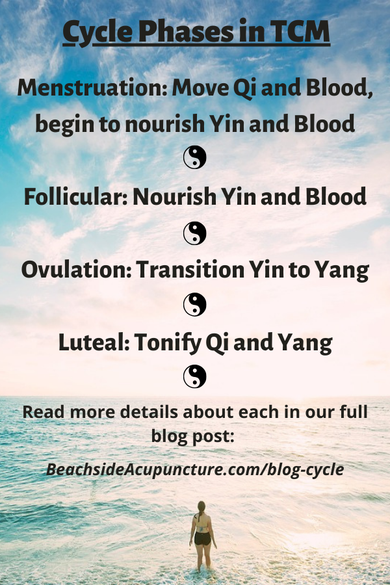
This post contains affiliate links, meaning Beachside Community Acupuncture PLLC may receive a small commission for purchases made through certain links at no additional cost to you. (In other words, you support us in a small way when you buy the products that we highly recommend and would use ourselves!) Click here to view our full disclosure policy.
Many women use the word "cycle" when discussing their period, but in reality a cycle reflects four phases, only one of which is menstruation. Think about other cycles that you know; how would you characterize them? An easy one to visualize is the cycle of seasons, where each has its hallmark signs, like the orange leaves of autumn and the blooming flowers of spring. Similarly, each phase of a woman's cycle has its own distinctions, and understanding them can provide a foundation for correcting imbalances like irregular cycles, PMS, and infertility. Here we'll include a brief synopsis of the phases and a few acupressure points that can be beneficial for them.
Menstruation
The first full day of a period is considered Day 1 of a cycle, and this phase is pretty obvious. Old uterine lining and hormones are cleared out and the slate is wiped clean for the next cycle, almost like a little detox. In Western medicine, this happens in response to a drop in progesterone, and estrogen starts to increase. In Traditional Chinese Medicine (TCM), the goal is always to work with the body, so we see this as a time to move Qi and Blood and start nourishing Blood and Yin (which roughly correspond to estrogen).
If you think you're having an issue with menstruation - or just want to give the body extra support - acupressure on points LV3, LI4, and SP6 can help if you know that you are definitely not pregnant. (Some women have light bleeding while they are pregnant, and these points are ones that we use to induce labor.) You can run a quick online search for "acupuncture point [point name] location" to find images of where they are on the body.
Follicular Phase
After having cleared out everything during menstruation, the uterus and ovaries begin preparing for another possible pregnancy. The follicular phase is characterized by follicles growing on the ovaries and is basically the time before ovulation. During this time, estrogen rises and Yin and Blood increase. Points like KD3 and LV8 can help this process.
Ovulation
A textbook-perfect cycle would be 28 days long with ovulation occurring at Day 14, but this isn't the case for most women. In reality it can happen much earlier or later than day 14, but in a balanced cycle it should be around that time. Ovulation is the release of an egg after a spike in luteinizing hormone (LH) and follicle stimulating hormone (FSH) and marks the transition from estrogen to progesterone. In TCM, this correlates to a shift from Yin to Yang and also involves some movement of Blood and Qi. Stimulating LI4, LV3, ST36, and KD7 can be of benefit here.
Some women experience symptoms around ovulation, such as a pinch in the lower abdomen or bloating, but without those, you may not notice that you're ovulating at all. If you're interested in regulating your cycle for fertility or general health, learn more about your ovulatory phase by testing with ovulation predictor kits (OPK), measuring basal body temperature (BBT), or watching for cervical mucus (CM) changes, all of which we cover in more detail in our blog on tracking fertility.
Luteal Phase
The days between ovulation and the next period are considered the luteal phase, during which progesterone rises in Western medicine and Qi and Yang rise in TCM. If an egg is fertilized during ovulation, it will travel down the fallopian tube to implant in the uterine lining and progesterone will continue to rise. If fertilization doesn't occur, progesterone will drop at the end of this phase to trigger another period.
Acupressure can vary in this phase depending on goals and symptoms.
- KD7 and ST36 are great points for Yang and Qi, but if you're trying to get pregnant, a point like SP6 that tonifies Qi but also induces labor is not a good choice.
- If you have severe PMS symptoms and aren't sure if you are pregnant, points like GB34 and SJ5 that promote movement but don't induce labor will be the safest options.
- If you know that you are not pregnant, you can use any points that you'd like! Going back to menstruation, LI4 and LV3 are strongly moving and clearing.

This post was meant to provide a basic foundation of knowledge so that you'll be more confident in reading about your cycle and discussing it with your healthcare providers. Our bodies are constantly giving us messages to alert us to imbalances, so keeping notes on the phases in which symptoms occur can offer insight into what needs to be supported and treated. If you'd like even more information on this topic, the book The Infertility Cure is a wonderful resource, regardless of whether or not you're currently trying to get pregnant.

Kathleen Ketola is a Licensed Acupuncturist and the owner of Beachside Community Acupuncture. She loves providing affordable acupuncture to the residents of McKinney, Texas, and surrounding cities like Prosper, Frisco, and Plano, but she also enjoys educating the general public on how acupuncture and Traditional Chinese Medicine (TCM) can treat everything from pain to infertility to stress and beyond. Click "Book Now" at the top of this page to book an appointment or feel free to contact her at (214) 417-2260.










Write a comment